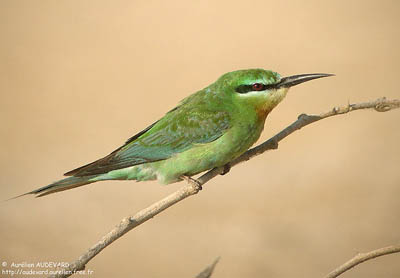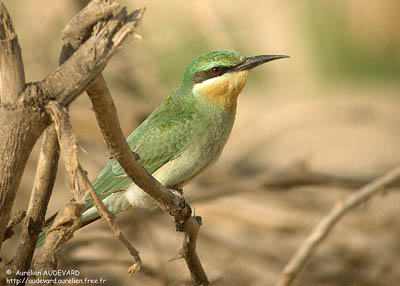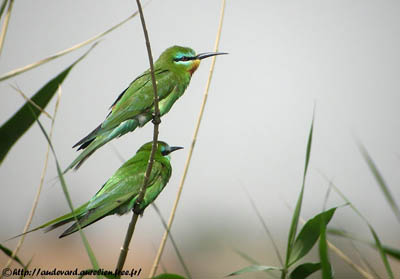
Blue-cheeked Bee-Eater
Merops persicus
Coraciiforme Order – Meropidae Family
BIOMETRICS:
Length: 27-31 cm
Wingspan: 46-49 cm
Weight: 38-50 g
DESCRIPTION:
Blue-cheeked Bee-Eater differs markedly from European Bee Eater in its predominantly bright green plumage and rufous-chesnut throat, with yellow only on chin. Elongated central tail feathers of adult are longer. It has longer, finer black bill, giving it a longer, more streamlined look than European.
Narrower black face mask bordered above and below by pale bands frequently whitish-looking than bluish, gives it distinctive facial expression, even at a distance when colours are hard to see.
In flight from below, look quite dark-throated, and underwings are much paler and obviously coppery overall with narrower, less obvious dark trailing edge.
DIET:
Blue-cheeked Bee-Eaters are insectivorous, eating mainly flying insects. They can eat dangerous insects such as bees, wasps and hornets which are rendered harmless before being eaten: the tail (and sting) of the insects is rubbed against the perch to express the venom and often the sting itself.
PROTECTION / THREATS / STATUS:
Blue-cheeked Bee-Eater is not globally threatened. It is a common and widespread species.
Fr: Guêpier de Perse
All : Blauwangenspint
Esp: Abejaruco Persa
Ital: Gruccione di Persia
Nd: Groene Bijeneter
Russe: Зеленая щурка
Sd: Grön biätare
Photos d’Aurélien Audevard
Son site : OUESSANT DIGISCOPING
Texte de Nicole Bouglouan
Sources :
HANDBOOK OF THE BIRDS OF THE WORLD Vol 6 by Josep del Hoyo-Andrew Elliott-Jordi Sargatal - Lynx Edicions, 2001 - ISBN: 848733430X
BIRDS OF THE MIDDLE EAST by R.F. Porter, S. Christensen, P Schiermacker-Ansen C.Helm - ISBN: 0713670169
THE HANDBOOK OF BIRD IDENTIFICATION FOR EUROPE AND THE WESTERN PALEARCTIC by Mark Beaman, Steve Madge - C.Helm - ISBN: 0713639601
Wikipedia (Wikipedia, The Free Encyclopedia)

Adult winter is slightly duller overall.
Juvenile is markedly duller and lacks elongated central tail feathers. Female is similar to the male but her tail feathers are shorter.
VOICE: SOUNDS BY XENO-CANTO
Blue-cheeked Bee-Eater’s call is a rapid, rippling trill “priip” or “driip” frequently repeated. The song is more disyllabic than European’s song, hoarser, less liquid, and shriller.
Its call is slightly higher-pitched, but ending is slightly lower-pitched.
HABITAT:
Blue-cheeked Bee-Eater breeds mainly in sand deserts near water fringed with bushes and acacia or tamarisks. It lives in open cultivation, with some trees and bushes, or dry uncultivated country with scattered bushes. Almost always found in close association with water in form of rivers, irrigation canals, lakes or marshes. It winters in open woodland and grassland.
RANGE:
Northern and sub Saharan Africa, from NE Egypt and the Near East through the Middle East and S Russian to Asia.

BEHAVIOUR:
Blue-cheeked Bee-Eater feeds by making long pursuit flights from perch, and even from the ground. It returns to perch to knock the prey and, if is a hymenoptera, to rub its tail.
It is migratory, moving in small or large flocks mainly by day, passing on broad front often at considerable height. They vacate breeding grounds in August. On long sea crossing, they have to migrate by night. It is a long distance migrant.
These bee-eaters are gregarious, nesting colonially in sandy banks. They feed and roost communally.
FLIGHT:
Blue-cheeked Bee-Eater pursues preys by flying rapidly from perch. It performs rapid wing beats, glides and abrupt twists. It has an agile flight.
REPRODUCTION:
Blue-cheeked Bee-Eater nests solitary or in loose colonies in sandy banks, on canal or ditch, low cliff and sandy mud plain.
They make a burrow 1 to 3 metres long, depending of softness of soil, nearly straight, and in level-declining 15/20 degrees. The nesting-chamber is at the end of the burrow.
Female lays 4 to 8 white eggs. Incubation lasts 23 to 26 days by both parents which also care the young together. The young fledge at about 23-26 days after hatching.
